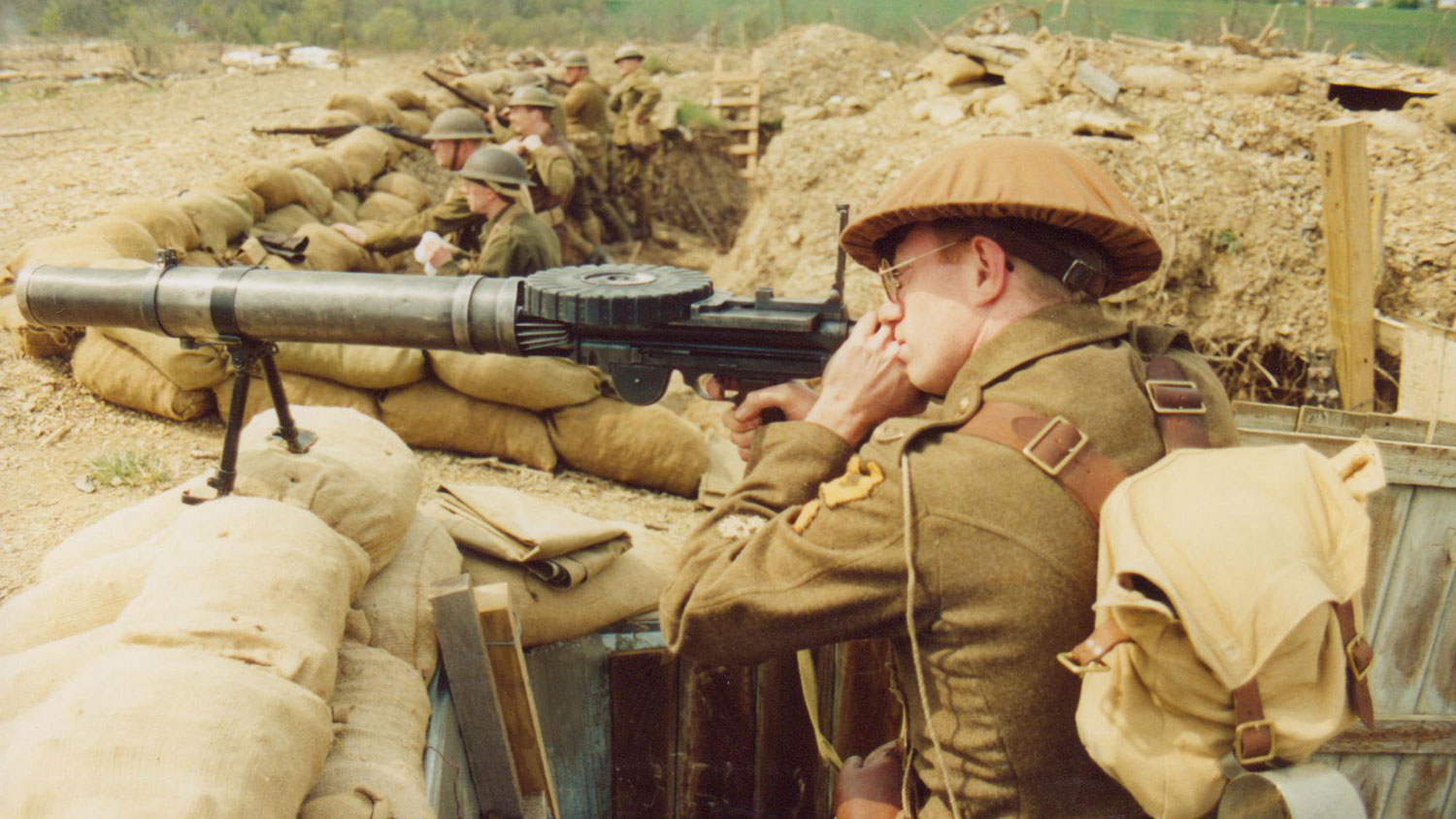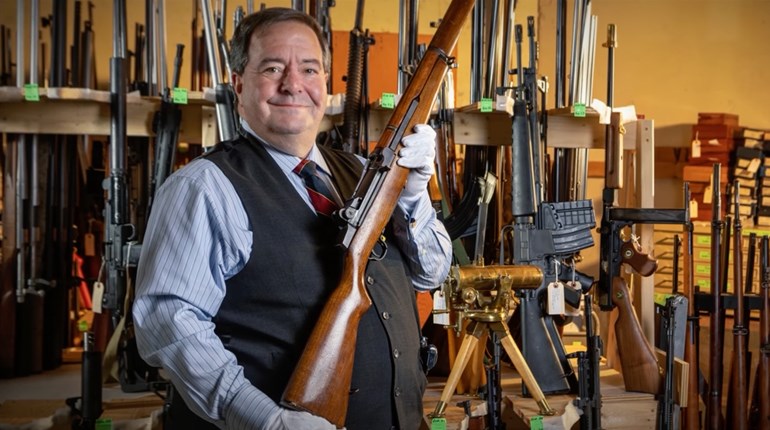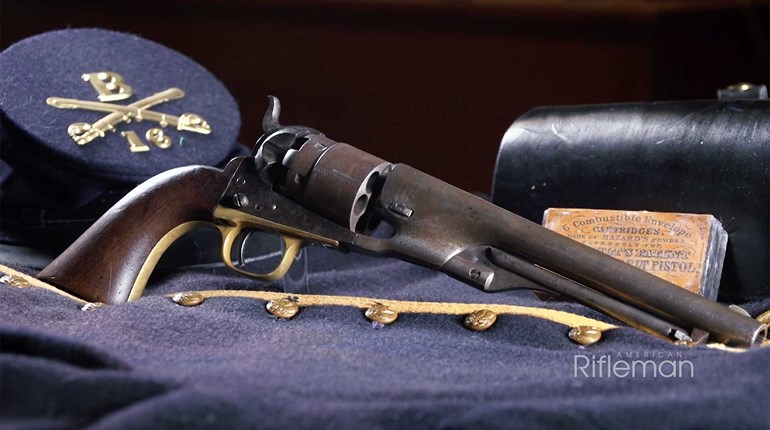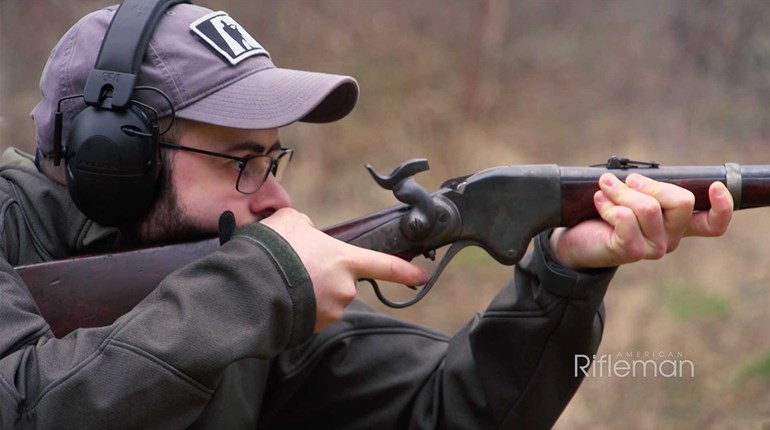** When you buy products through the links on our site, we may earn a commission that supports NRA's mission to protect, preserve and defend the Second Amendment. **

Above: A World War I reenactor in the trenches with a Lewis Light Machine Gun.
No Man’s Land—As we crawled closer to their lines, we could make out the hushed tones of the German sentries talking amongst themselves, an indication our advance had gone unnoticed. Our company sergeant major motioned us closer to the parapet of the trench. On his signal, three hand grenades were hurled over the tops of the sandbags. We hugged the earth until we heard the blast of the bombs. As cries of astonishment, alarm and agony rose from within the trench, we sprang to our feet and pressed ahead. Hoisting the machine gun to waist height, I began to unleash the Maxim on the survivors. The muzzle flash illuminated the length of trench like a strobe light, and German soldiers responded by clutching and twisting in a dance of death. My brother turned toward me, and said, grinning fiendishly, “Save some of the Huns for me!”
Saving Germans for killing later would be no problem. No sooner had the machine gun finished barking than our sergeant gave the all-clear, and everyone, dead, wounded and alive, stood up and brushed the dust and dirt from their uniforms. “Great job, man, you guys really surprised us that time,” said one German corporal as he swept clouds of baking soda from his tunic. “That first grenade blew up right on top of me. I’m completely covered in powder.” We shook hands before gathering our empty ammo belts and trudging back to our own lines. Baking soda? By now, I’m sure you realize that grenades from the First World War didn’t contain that. In fact, if you’ve ever read anything about the war, you know that it was far more gruesome than I have illustrated here with words. You’ve been reading a description of a World War I combat reenactment.
As a young student obsessed with military history, I couldn’t read enough about wars and soldiers. I always wished I had a way to experience what they did—their lives and the battles that were such a major factor in my imagination. Some people with the same desire to “get a feel for what it was like” paint scale models or play board or computer games that test their tactical and strategic skills. But if you truly want to gain a small sense of what it means to be a soldier from a given time period, another avenue exists —military reenacting.
Today’s wannabe warriors can learn about soldiering through any of the thousands of reenactment units that portray military life, from the Roman legions all the way up to the last Persian Gulf War. This not-quite-mainstream hobby is popular across this country and overseas, and reenactors have been portrayed in books as well as parodies on a number of “Simpsons” episodes and in the film, “Sweet Home Alabama.”
 What is it?
What is it?
Reenacting is a hobby, recognized by the National Rifle Association as a legitimate component of the shooting sports. Reenactors spend a considerable amount of time, money and interest in understanding a specific time period, some especially drawn by the chance to shoot guns from a specific war, while others seek a keen understanding of how soldiers lived and what their battles were like.
Reenactors learn how to use and handle real firearms safely. In recreated “battles,” of course only blank ammunition is fired. Much like in the real military, reenactors generally eat, sleep, drill and fight in a specific unit they have joined. Most battles are fought using the tactics of the time, following scripted movements that mimic actual historic events.
What is required?
A strong desire to be part of a group portraying a period of time that interests you is all that it takes to get started. Take, for instance, the American Civil War of 1861 to 1865. By far the most popular of all reenacting periods, the Civil War has units spread throughout most of the United States and even in Australia, Germany and England. Most likely there is a nearby unit that will be happy to sign up a new recruit, and even if you are a closet Rebel living on Long Island, there are more than a few southern units “behind enemy lines,” just as there are a few well-concealed outfits doing Yankee impressions in Alabama!
An “impression” is the type of soldier you want to portray and the uniforms, equipment and firearms that fit the chosen time period. Many different types of impressions exist. Decide what impression you would like to portray, then look for an appropriate unit near you. There are numerous websites, such as www.reenactor.net, that can put you on the right track.
For instance, from our Civil War period, your impression you can be a standard infantryman, an artillerist, or if you have access to a horse, you can join the cavalry. Most units require a new recruit to be at least 16 years old to handle a firearm in the ranks, but don’t let that discourage you—many youngsters find their way into the hobby as buglers, drummers, messengers and more.
Firearms for impressions before 1898 require what we consider today “antique” weapons. Most units discourage the use of original guns, so get one of the many fine reproduction flintlock and percussion blackpowder firearms available today. For events in the post-1898 era, original firearms are your only source for now. Some can be valuable collectibles, but most reenactors look for what they call “shooter” or “trench-grade” firearms that won’t lose much collectors’ interest if they get banged up.
Uniform requirements are established by each unit, so don’t buy one until you check with your unit commander first. Chances are they have a source or supplier of uniforms that meet their standards of authenticity. Many companies sell proper uniforms and equipment. And things like belts, canteens, cups and utensils can be had from “sutlers,” the traveling salespeople who set up tents at reenactment events. Most sutlers keep a good supply of merchandise on hand, and many have websites dedicated to selling period-correct wares.
Why get involved?
As we said earlier, reenacting offers you a chance to “time travel” and come away with a better idea what it was like to have been a soldier back then. You will get first-hand knowledge of carrying a heavy pack into battle and how boring drilling and marching can be. At the same time, you gain expertise with period firearms and the awesome effect they had in battle. You will also forge friendships with new people, all with similar interests to your own.
Reenacting was never meant to trivialize war or its cruel residue. Granted, reenactors survive their “deadly” encounters with the enemy every weekend, and live to fight another day. Even though you do not actually put yourself in harm’s way, reenacting can get you closer than any book to understanding what battle is like and the hardships soldiers faced. You’ll also gain a sense of what it was like to fight for a cause and how important the actual sacrifices made by our uniformed men and women are to us and our way of life.
No Man’s Land—As we crawled closer to their lines, we could make out the hushed tones of the German sentries talking amongst themselves, an indication our advance had gone unnoticed. Our company sergeant major motioned us closer to the parapet of the trench. On his signal, three hand grenades were hurled over the tops of the sandbags. We hugged the earth until we heard the blast of the bombs. As cries of astonishment, alarm and agony rose from within the trench, we sprang to our feet and pressed ahead. Hoisting the machine gun to waist height, I began to unleash the Maxim on the survivors. The muzzle flash illuminated the length of trench like a strobe light, and German soldiers responded by clutching and twisting in a dance of death. My brother turned toward me, and said, grinning fiendishly, “Save some of the Huns for me!”
Saving Germans for killing later would be no problem. No sooner had the machine gun finished barking than our sergeant gave the all-clear, and everyone, dead, wounded and alive, stood up and brushed the dust and dirt from their uniforms. “Great job, man, you guys really surprised us that time,” said one German corporal as he swept clouds of baking soda from his tunic. “That first grenade blew up right on top of me. I’m completely covered in powder.” We shook hands before gathering our empty ammo belts and trudging back to our own lines. Baking soda? By now, I’m sure you realize that grenades from the First World War didn’t contain that. In fact, if you’ve ever read anything about the war, you know that it was far more gruesome than I have illustrated here with words. You’ve been reading a description of a World War I combat reenactment.
As a young student obsessed with military history, I couldn’t read enough about wars and soldiers. I always wished I had a way to experience what they did—their lives and the battles that were such a major factor in my imagination. Some people with the same desire to “get a feel for what it was like” paint scale models or play board or computer games that test their tactical and strategic skills. But if you truly want to gain a small sense of what it means to be a soldier from a given time period, another avenue exists —military reenacting.
Today’s wannabe warriors can learn about soldiering through any of the thousands of reenactment units that portray military life, from the Roman legions all the way up to the last Persian Gulf War. This not-quite-mainstream hobby is popular across this country and overseas, and reenactors have been portrayed in books as well as parodies on a number of “Simpsons” episodes and in the film, “Sweet Home Alabama.”

Navy Arms offers the Civil War-era replica Parker Hale Whitworth.
Reenacting is a hobby, recognized by the National Rifle Association as a legitimate component of the shooting sports. Reenactors spend a considerable amount of time, money and interest in understanding a specific time period, some especially drawn by the chance to shoot guns from a specific war, while others seek a keen understanding of how soldiers lived and what their battles were like.
Reenactors learn how to use and handle real firearms safely. In recreated “battles,” of course only blank ammunition is fired. Much like in the real military, reenactors generally eat, sleep, drill and fight in a specific unit they have joined. Most battles are fought using the tactics of the time, following scripted movements that mimic actual historic events.
What is required?
A strong desire to be part of a group portraying a period of time that interests you is all that it takes to get started. Take, for instance, the American Civil War of 1861 to 1865. By far the most popular of all reenacting periods, the Civil War has units spread throughout most of the United States and even in Australia, Germany and England. Most likely there is a nearby unit that will be happy to sign up a new recruit, and even if you are a closet Rebel living on Long Island, there are more than a few southern units “behind enemy lines,” just as there are a few well-concealed outfits doing Yankee impressions in Alabama!
An “impression” is the type of soldier you want to portray and the uniforms, equipment and firearms that fit the chosen time period. Many different types of impressions exist. Decide what impression you would like to portray, then look for an appropriate unit near you. There are numerous websites, such as www.reenactor.net, that can put you on the right track.
For instance, from our Civil War period, your impression you can be a standard infantryman, an artillerist, or if you have access to a horse, you can join the cavalry. Most units require a new recruit to be at least 16 years old to handle a firearm in the ranks, but don’t let that discourage you—many youngsters find their way into the hobby as buglers, drummers, messengers and more.
Firearms for impressions before 1898 require what we consider today “antique” weapons. Most units discourage the use of original guns, so get one of the many fine reproduction flintlock and percussion blackpowder firearms available today. For events in the post-1898 era, original firearms are your only source for now. Some can be valuable collectibles, but most reenactors look for what they call “shooter” or “trench-grade” firearms that won’t lose much collectors’ interest if they get banged up.
Uniform requirements are established by each unit, so don’t buy one until you check with your unit commander first. Chances are they have a source or supplier of uniforms that meet their standards of authenticity. Many companies sell proper uniforms and equipment. And things like belts, canteens, cups and utensils can be had from “sutlers,” the traveling salespeople who set up tents at reenactment events. Most sutlers keep a good supply of merchandise on hand, and many have websites dedicated to selling period-correct wares.
Why get involved?
As we said earlier, reenacting offers you a chance to “time travel” and come away with a better idea what it was like to have been a soldier back then. You will get first-hand knowledge of carrying a heavy pack into battle and how boring drilling and marching can be. At the same time, you gain expertise with period firearms and the awesome effect they had in battle. You will also forge friendships with new people, all with similar interests to your own.
Reenacting was never meant to trivialize war or its cruel residue. Granted, reenactors survive their “deadly” encounters with the enemy every weekend, and live to fight another day. Even though you do not actually put yourself in harm’s way, reenacting can get you closer than any book to understanding what battle is like and the hardships soldiers faced. You’ll also gain a sense of what it was like to fight for a cause and how important the actual sacrifices made by our uniformed men and women are to us and our way of life.







































